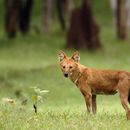en
names in breadcrumbs


Perception Channels: tactile ; chemical
There are 10 subspecies of the dhole ranging in color and size. Two of the subspecies are listed as endangered by the IUCN (east asian dhole and the west indian dhole). Two other subspecies are on the verge of extinction ( C.a. primaerus, and the C.a. laniger).
CITES: appendix ii
IUCN Red List of Threatened Species: endangered
Although this occurs on rare occasions, dholes can attack livestock at the cost of the owner.
Dholes have become an indirect food source for the residents of the jungles. Dholes do not attack human beings, and they usually retreat at the sight of a person. Human residents of the jungle follow dholes when they are hunting. When the dhole ccompletes its kill, the human hunters scare it away and steal its kill.
The dhole eats wild berries, insects, and lizards. Packs of dholes feast on mammals ranging from rodents to deer. Some of the dhole's favorites include wild pigs, hares, wild goats, sheep, and occasionally a monkey. Unlike many other "dogs," the dhole seldom kills by biting the throat. Larger mammals are attacked from the rear, while smaller ones are caught by any part of the bodies. The smaller mammals are killed by a swift blow to the head; the larger mammals are immediately disembowled. Dholes compete for the food, not by fighting, but by how fast they can eat. An adult dhole can eat up to 4kg (8.8lbs) of meat in one hour. Two to three dholes can kill a 50kg (110 lb) deer in less than two minutes, and they begin to feed on it before it is dead. The larger prey rarely die from the attack itself, but from blood loss and shock as their intestines, heart, liver, and eyes are feasted upon.
Animal Foods: mammals; reptiles; insects
Plant Foods: fruit
Primary Diet: omnivore
From the Altai Mountains in Manchuria in Central and Eastern Asia, its range spreads southwards through the forest tracts of India, Burma, and the Malayan Archipelago. Three races of the dhole exist in India alone
(Trans-Himalayan, Himalayan, and Peninsular).
Biogeographic Regions: palearctic (Native ); oriental (Native )
Dholes like open spaces and can often be found on jungle roads, river beds, jungle clearings, and paths, where they rest during the day. Their hunting range is about 40sq km (15sq mi). The dhole can also be found in dense forest steppes, and the thick jungles of the plains as well as the hills. They are never found in the open plains and deserts.
Terrestrial Biomes: forest ; rainforest ; scrub forest
Average lifespan
Status: captivity: 16.0 years.
The dhole is an average size canine with head/body length 90cm (35"), tail length 40-45cm (16"-18"), and shoulder height 50cm (20"). The dhole is set apart from other canids in that it has an unusually thick muzzle and one less molar tooth on each side of its lower jaw. Other members of the family Canidae have a total of 42 teeth. The adult dhole is characterized by a rusty red coat with a pale underside; depending on the region, pelage may vary from light brownish gray to a uniform red coat. A dhole is born with a sooty brown color, acquiring an adult color at three months of age. Dholes also have dark, almost always black, bushy tails.
Range mass: 17 to 21 kg.
Other Physical Features: endothermic ; bilateral symmetry
Each pack contains a dominant monogamous pair. Subordinate pack members help care for the young of the dominant pair.
Mating System: monogamous ; cooperative breeder
The dhole's gestation period is 60-62 days. The mother usually gives birth to eight pups at a time. The pups reach sexual maturity at about a year. Pups are born throughout the end of fall, winter, and the first spring months ( November - March ). Female dhole can have up to 16 mammae, suggesting their ability to take care of large litters. Dens are constructed near streambeds or among rocks. After a female dhole has given birth, a few other adults take part in feeding the mother as well as the pups. The pups, as early as the tender age of three weeks, and the mother are fed regurgitated meat.
Range number of offspring: 2 to 6.
Average number of offspring: 3.5.
Range gestation period: 60 to 63 days.
Average weaning age: 58 days.
Key Reproductive Features: gonochoric/gonochoristic/dioecious (sexes separate); sexual
Average birth mass: 275 g.
Average number of offspring: 5.
Average age at sexual or reproductive maturity (male)
Sex: male: 365 days.
Average age at sexual or reproductive maturity (female)
Sex: female: 365 days.
Parental Investment: altricial ; post-independence association with parents; extended period of juvenile learning